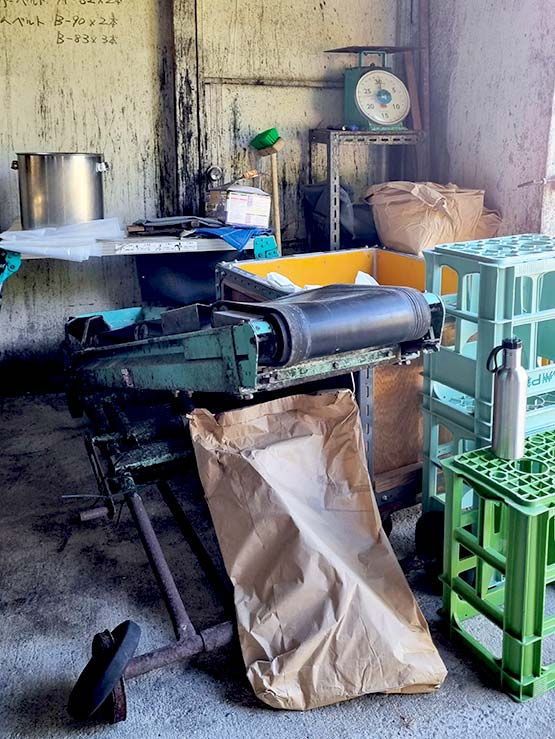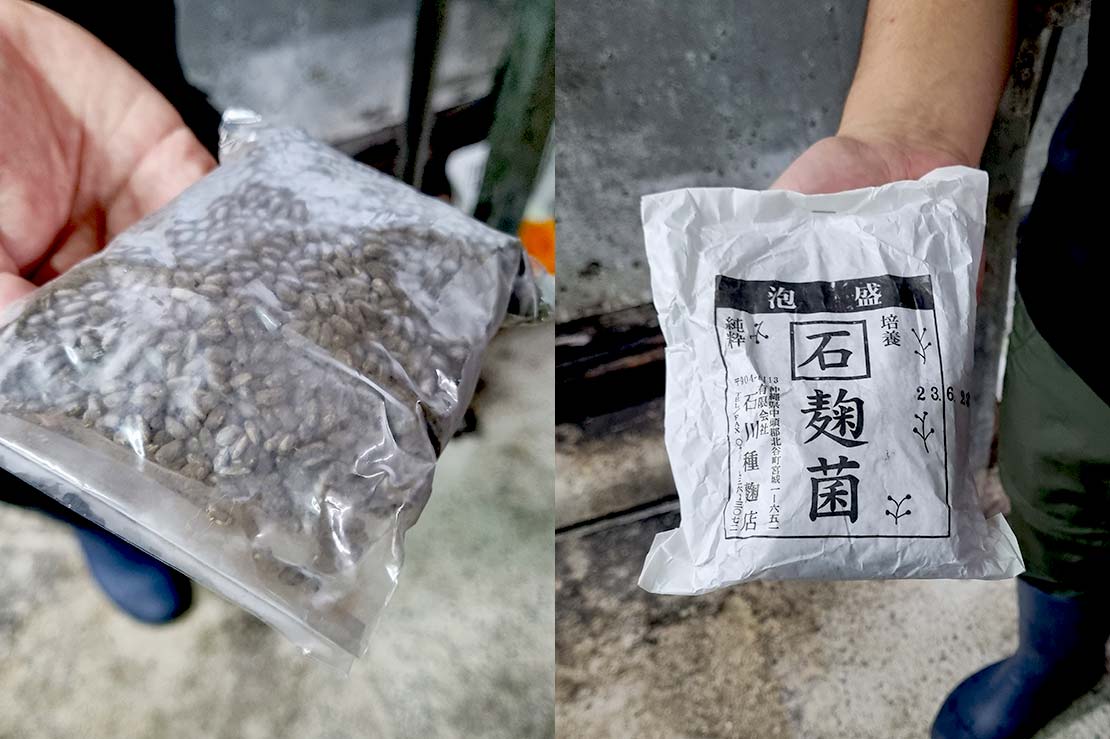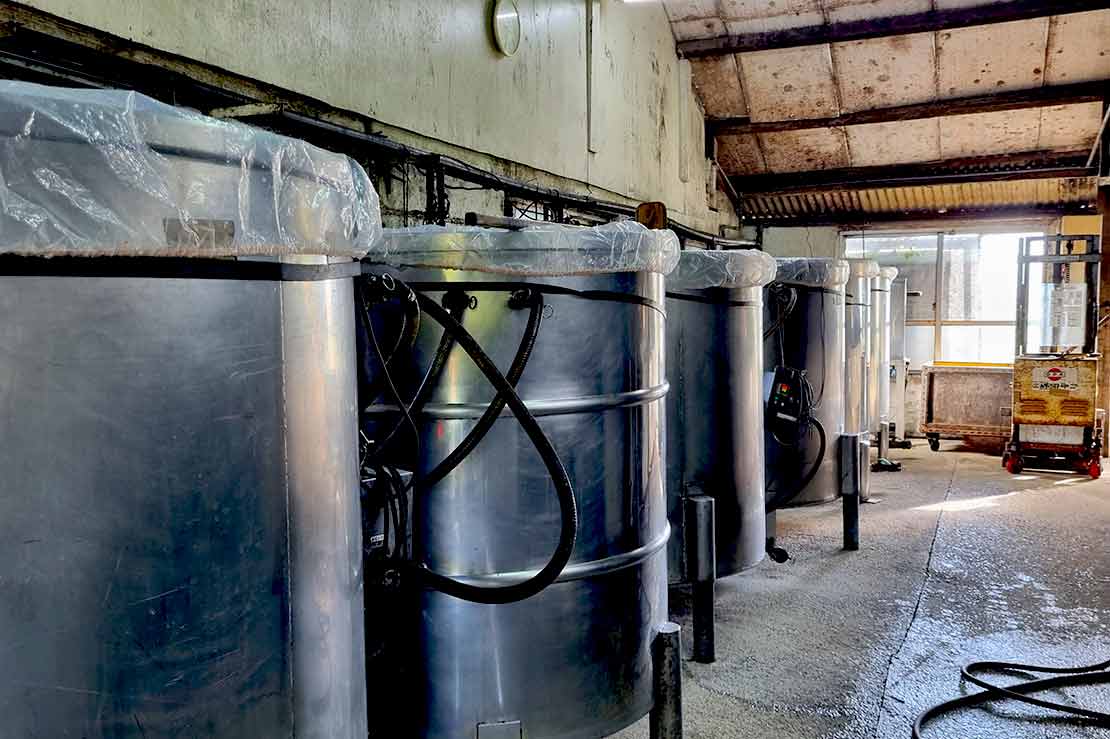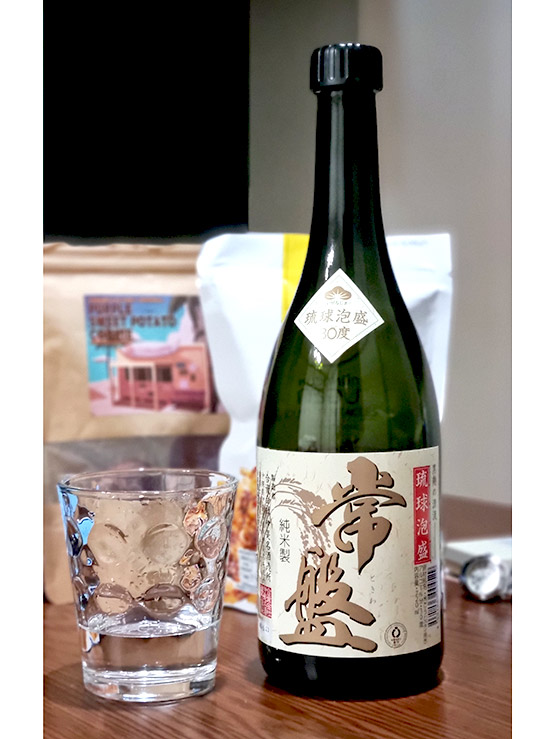Izena Awamori Distillery has a unique historical background. Before it was established (incorporated in 1971) in 1949, Terunobu Nakada, the current president Junya Nakada's grandfather, and several relatives secretly brewed Awamori until the revival of the awamori alcohol category in 1946.
Junya Nakada has been working at Izena Awamori Distillery as a master brewer for five years, returning from training at other sake breweries. He learned a lot of things through experiencing various processes at other sake breweries. Given the experience, he was the ideal candidate for a master brewer at Izena Awamori Distillery when the second-generation president decided to retire.

The fourth-generation master brewer, Junya Nakada [Photo: Kim Choong]
The first and only distillery on Izena
Post-World War II, the United States Military Government banned alcohol production in Japan. However, recognising the necessity to resume production, five breweries and distilleries were established in 1946.
The crucial component in awamori production, known as Kuro-Koji, was thought to be lost during World War II but was rediscovered by Seiryou Sakumoto in Shuri around 1945. In a generous gesture, Sakumoto distributed the koji spore for free, aiming to revive the significant cultural heritage of the Ryukyu Kingdom, reflecting Okinawa's rich historical legacy. Fortunately, like many others in Okinawa, Nakada's family seized the opportunity and resumed production. When alcohol production licenses were issued in Japan, Izena Awamori Distillery was founded as the first company incorporated on Izena Island in 1945.
We went on a trip to Izena Island with an interpreter, Naoaki Miyagi (Nao) to explore their production process and the island itself. Nao is not only Junya’s cousin but also the son of the previous president.

It's another day of brewing at Izena Awamori Distillery! [Photo: Kim Choong]
There are 2 ferries from Okinawa mainland's Unten Port to Izena Island in a day. We took the first ride at 10.30am and took about an hour. Following our arrival, we sought transportation and lunch, preparing for an adventurous tour of the island – a gem adrift in the East China Sea and the birthplace of Shō En (尚圓, 1415–1476), founder of the Second Sho Dynasty, king of Ryukyu Kingdom (now Okinawa).
A little hands-on experience
Little did we know, Junya had arranged for us to actively partake in the awamori-making process! Our responsibilities included blending Kuro-Koji with steamed rice and engaging in the rhythmic stirring of Moromi, tasks that proved to be both fun and physically demanding.
Through his detailed explanation and the patience of Nao’s translation, we learned the comprehensive Awamori-making process, from raw ingredients to mash, fermentation, and distillation.

Rice bed where Kome-Koji rests at the first stage of fermentation [Photo: Kim Choong]
[Read: What is awamori and how is it made?]
Raw ingredients
The distillery is Junya's creative playground, where he experiments with various recipes and tweaks ingredients to achieve desired outcomes. In his planning, he considers Kome-Koji, unrefined sake, distillation, and processes depending on the quality of Awamori he wants to make. Taking into consideration the type of rice and Kome-Koji, and especially for Kusu (Awamori that has been aged for more than three years), he aims for a balanced and flavourful finish that is characteristic of the island. He always thinks about the quality of the sake from the stage of washing the rice, the very first step of making Awamori.

Left: Izena Awamori Distillery's bespoke Kuro-Koji using local brown rice; right: Common Kuro-Koji [Photo: Kim Choong]
The brewing process begins with rice polishing of Thai indica rice. Then, the rice is soaked in water until it absorbs the necessary moisture. He manually puts 840 kilograms of Thai indica rice into a drum and steams it for an hour. Once the rice temperature reduces to around 44°C which takes about another hour, Tane-Koji (brown rice with propagated Kuro-Koji) is spread into the rice. The common type Kuro-Koji is used for Izena’s main products.

Drums for washing and steaming rice, and for putting Tane-Koji into [Photo: Kim Choong]
Experimenting with Recipes
Junya pursues the best quality, in other words, he is dedicated to getting his recipes perfect, refining them one batch at a time. He humbly accepts that the true results of certain tanks will only be revealed many years later. In fact, it needs some time called “Jukusei” which means an aging process bringing out richer, more intricate flavours and exquisite smoothness after distillation and storing. This process is essential for making the best Awamori. He expresses hope that the 10-year tank will yield exceptional results when its time finally arrives.
The making of moromi
The fermentation environment significantly influences the spirit's flavours. The yeast and spores in the distillery's air interact with the Moromi (fermentation mash) over the years, creating a unique environment for each distillery and its awamori.
Moromi is made from Kome-Koji (steamed rice with Kome-Koji mold), yeast, and water. While shochu usually uses two fermentations, Awamori is manufactured by a simple method of "all-koji mashing" and "single distillation," in which mashing and distillation are undertaken only once.
Awamori is created in various flavours through ingenuity applied to the time and temperature of each process, the distillation, and filtration methods adopted by distillers and brands alike. The rice is kept in tanks for about a few weeks, and alcohol is produced through a parallel double fermentation process in which saccharification (enzymes in the koji mold break down starch into glucose) and alcoholic fermentation (enzymes in the yeast produce alcohol from glucose) are conducted simultaneously.

Pushing down the rice that floats atop the Moromi tank to ensure even ermentation. [Photo: Kim Choong]
A new generation of terroir specific products
Entering the distillery, we were greeted by dimly lit surroundings and walls bearing dark spots reminiscent of craft beer's wild fermentation room. The atmosphere evoked enchantment as if someone were brewing potent concoctions capable of bewitching a village – a manifestation of the distillery's magic.
At Izena Awamori Distillery, Awamori with an alcohol content of 40%-50% is made by distilling fermented Moromi after 17%-18% alcohol is produced through fermentation of Moromi for about 20 days. His unique approach involves using head and tail cuts, and then moving to a storage tank after distillation. After storage, water is added to the spirit, depending on each product, to lower the alcohol content before bottling.
When it comes to the 10-year-old batch, he fills the distillery’s small batch into a tank only for it little by little. At the time of our visit, the tank was yet to be filled and it was a time-honoured process where he would draw a small tasting potion each time and decide on the next blend to enter the tank.
Preserving Heritage and Fostering Growth

Izena Island's scenic view [Photo: Kim Choong]
Izena Island holds a pivotal role in the historical tapestry of the Ryukyu Kingdom, being the birthplace of Sho En, the first king of the Second Sho Dynasty. His profound intellect set the foundation for the kingdom's prosperity. The island boasts numerous cultural properties and artifacts dating back as far as 3,000 years, creating a rich historical backdrop complemented by its scenic landscapes just an hour away from the mainland – an enticing combination for visitors.
Despite its historical and natural allure, Izena faces the challenge of attracting a younger demographic. As the population ages and the workforce diminishes, the island aims to rejuvenate itself and become an appealing destination for the youth. Keen to promote the island and encourage young entrepreneurs, Junya collaborates with the local government, leveraging their products to raise awareness of Izena Island's unique charm.
Izena’s diverse range of awamori
Izena Awamori Distillery takes pride in its diverse range of Awamori products, spanning from unaged varieties to those aged 3, 5, and 10 years. These are stored in tanks and jars, with alcohol content ranging from 20% to 44%.

Izena Awamori Distillery's unaged awamori [Photo: Kim Choong]
One of the things Junya learned from his time at other sake breweries is how much influence Koji has on Awamori on the final result. Taking advantage of Izena Island's 400-year history of rice cultivation, he incorporates special "Tane-Koji" made from brown rice grown in Izena, along with "Shoen no Sato" ("Hitomebore" japonica rice) in his annual special menu. This not only emphasises the island’s “terroir” but also showcases his commitment to quality.

Shoen no Sato [Photo: Kim Choong]
“Shoen no Sato 30%” named after the birthplace of King Sho en of the Ryukyu Kingdom, was awarded the Superior Gold prize in the shochu category at the Tokyo Whiskey Spirits Competition (TWSC) 2022.
Their latest limited edition “Shoen no Sato Shimmer #13, bottled at 44%, distinguishes itself from the regular “Shoen no Sato” through three distinctive measures: 1) utilising the highest alcohol content possible, 2) limiting all raw ingredients exclusively from Izena Island, and 3) opting for a non-filtered option. The result is a captivating blend, capturing a grainy aroma while delivering a smooth mouthfeel, accentuating the sweet and soft texture of the liquid.
View Izena Awamori Distillery’s full range of products here.
- T -
